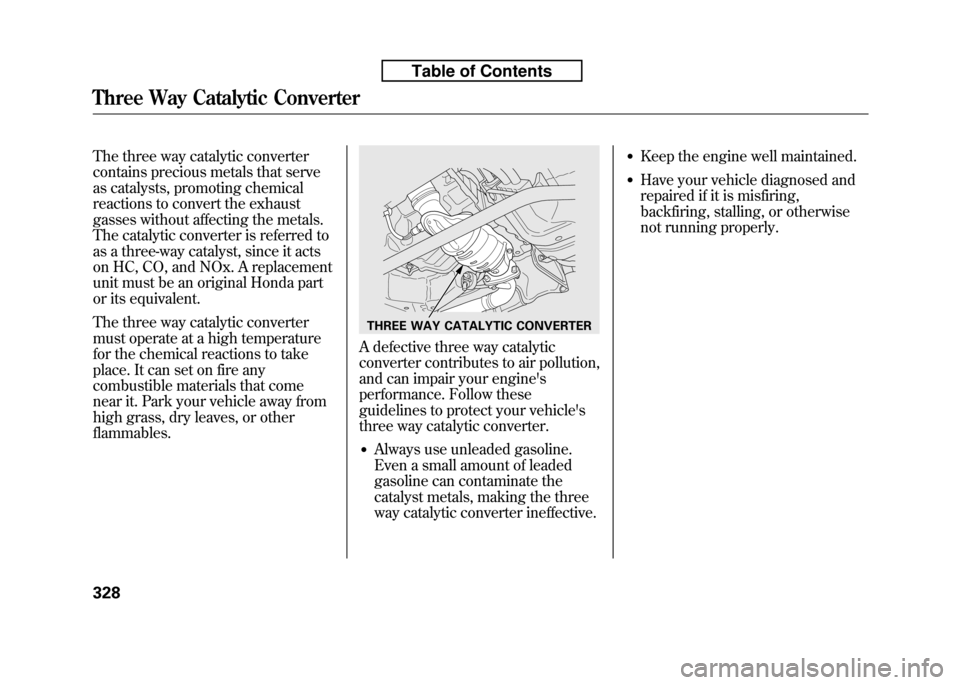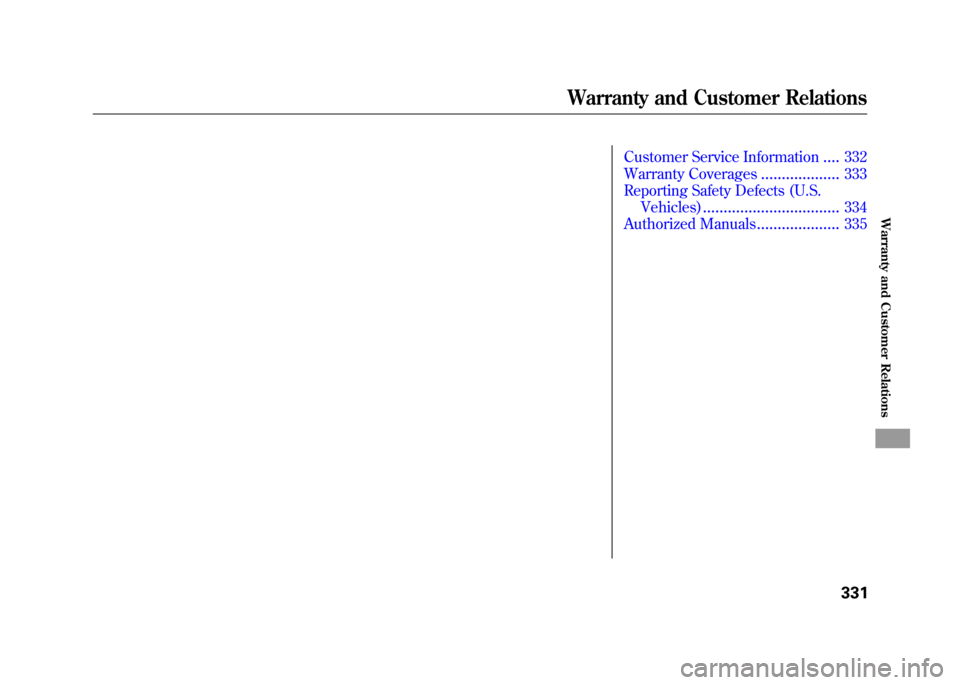HONDA FIT 2010 2.G Owners Manual
Manufacturer: HONDA, Model Year: 2010, Model line: FIT, Model: HONDA FIT 2010 2.GPages: 351, PDF Size: 5.67 MB
Page 341 of 351

The burning of gasoline in your
vehicle's engine produces several
byproducts. Some of these are
carbon monoxide (CO), oxides of
nitrogen (NOx), and hydrocarbons
(HC). Gasoline evaporating from the
tank also produces hydrocarbons.
Controlling the production of NOx,
CO, and HC is important to the
environment. Under certain
conditions of sunlight and climate,
NOx and HC react to formphotochemical‘‘smog. ’’Carbon
monoxide does not contribute to
smog creation, but it is a poisonousgas.
The Clean Air Act
The United States Clean Air Act
ꭧ
sets standards for automobile
emissions. It also requires that
automobile manufacturers explain to
owners how their emissions controls
work and what to do to maintain
them. This section summarizes how
the emissions controls work.
ꭧIn Canada, Honda vehicles comply
with the Canadian emission
requirements, as specified in an
agreement with Environment
Canada, at the time they are
manufactured.
Crankcase Emissions Control System
Your vehicle has a positive crankcase
ventilation system. This keeps
gasses that build up in the engine's
crankcase from going into the
atmosphere. The positive crankcase
ventilation valve routes them from
the crankcase back to the intake
manifold. They are then drawn into
the engine and burned. Evaporative Emissions ControlSystem
As gasoline evaporates in the fuel
tank, an evaporative emissions
control canister filled with charcoal
adsorbs the vapor. It is stored in this
canister while the engine is off. After
the engine is started and warmed up,
the vapor is drawn into the engine
and burned during driving.
Onboard Refueling Vapor Recovery
The onboard refueling vapor
recovery (ORVR) system captures
the fuel vapors during refueling. The
vapors are adsorbed in a canister
filled with activated carbon. While
driving, the fuel vapors are drawn
into the engine and burned off.
Emissions Controls
326
Table of Contents
Page 342 of 351

Exhaust Emissions Controls
The exhaust emissions controls
include four systems: PGM-FI,
ignition timing control, exhaust gas
recirculation, and three way catalytic
converter. These four systems work
together to control the engine's
combustion and minimize the
amount of HC, CO, and NOx that
come out the tailpipe. The exhaust
emissions control systems are
separate from the crankcase and
evaporative emissions controlsystems.PGM-FI System
The PGM-FI system uses sequential
multiport fuel injection. It has three
subsystems: air intake, engine
control, and fuel control. The
powertrain control module (PCM) in
automatic transmission vehicles or
the engine control module (ECM) in
manual transmission vehicles uses
various sensors to determine how
much air is going into the engine. It
then controls how much fuel to inject
under all operating conditions.
Ignition Timing Control System
This system constantly adjusts the
ignition timing, reducing the amount
of HC, CO, and NOx produced.
Exhaust Gas Recirculation (EGR)System
The exhaust gas recirculation (EGR)
system takes some of the exhaust gas
and routes it back into the intake
manifold. Adding exhaust gas to the
air/fuel mixture reduces the amount
of NOx produced when the fuel is burned.
Three Way Catalytic Converter
The three way catalytic converter is
in the exhaust system. Through
chemical reactions, it converts HC,
CO, and NOx in the engine's exhaust
to carbon dioxide (CO 2), nitrogen
(N 2), and water vapor.
Replacement Parts
The emissions control systems are
designed and certified to work
together in reducing emissions to
levels that comply with the Clean Air
Act. To make sure the emissions
remain low, you should use only new
Honda replacement parts or their
equivalent for repairs. Using lower
quality parts may increase the
emissions from your vehicle.
The emissions control systems are
covered by warranties separate from
the rest of your vehicle. Read your
warranty manual for moreinformation.
Emissions Controls
327
Technical Information
Table of Contents
Page 343 of 351

The three way catalytic converter
contains precious metals that serve
as catalysts, promoting chemical
reactions to convert the exhaust
gasses without affecting the metals.
The catalytic converter is referred to
as a three-way catalyst, since it acts
on HC, CO, and NOx. A replacement
unit must be an original Honda part
or its equivalent.
The three way catalytic converter
must operate at a high temperature
for the chemical reactions to take
place. It can set on fire any
combustible materials that come
near it. Park your vehicle away from
high grass, dry leaves, or otherflammables.
A defective three way catalytic
converter contributes to air pollution,
and can impair your engine's
performance. Follow these
guidelines to protect your vehicle's
three way catalytic converter.● Always use unleaded gasoline.
Even a small amount of leaded
gasoline can contaminate the
catalyst metals, making the three
way catalytic converter ineffective. ●
Keep the engine well maintained.
● Have your vehicle diagnosed and
repaired if it is misfiring,
backfiring, stalling, or otherwise
not running properly.
THREE WAY CATALYTIC CONVERTER
Three Way Catalytic Converter
328
Table of Contents
Page 344 of 351

Testing of Readiness Codes
If you take your vehicle for an
emissions test shortly after the
battery has been disconnected or
gone dead, it may not pass the test.
This is because of certain‘‘readiness
codes ’’that must be set in the on-
board diagnostics for the emissions
systems. These codes are erased
when the battery is disconnected,
and set again only after several days
of driving under a variety ofconditions. If the testing facility determines that
the readiness codes are not set, you
will be requested to return at a later
date to complete the test. If you must
get the vehicle retested within the
next two or three days, you can
condition the vehicle for retesting by
doing the following.
1. Make sure the gas tank is nearly,
but not completely, full (around 3/4).
2. Make sure the vehicle has been parked with the engine off for 6
hours or more.
3. Make sure the ambient temperature is between 40° and95°F. 4. Without touching the accelerator
pedal, start the engine, and let it
idle for 20 seconds.
5. Keep the vehicle in Park (automatic transmission) or
neutral (manual transmission).
Increase the engine speed to 2,000
rpm, and hold it there until the
temperature gauge rises to at least
1/4 of the scale (about 3 minutes).
6. Without touching the accelerator pedal, let the engine idle for 20seconds.
CONTINUED
Emissions Testing
329
Technical Information
Table of Contents
Page 345 of 351

7. Select a nearby lightly traveledmajor highway where you can
maintain a speed of 50 to 60 mph
(80 to 97 km/h) for at least 20
minutes. Drive on the highway in
D (automatic) or 5th (manual). Do
not use the cruise control. When
traffic allows, drive for 90 seconds
without moving the accelerator
pedal. (Vehicle speed may vary
slightly; this is okay.) If you cannot
do this for a continuous 90
seconds because of traffic
conditions, drive for at least 30
seconds, then repeat it two more
times (for a total of 90 seconds). 8. Then drive in city/suburban traffic
for at least 10 minutes. When
traffic conditions allow, let the
vehicle coast for several seconds
without using the accelerator pedal
or the brake pedal.
9. Make sure the vehicle has been parked with the engine off for 30minutes.
If the testing facility determines the
readiness codes are still not set, see
your dealer.
Emissions Testing
330
Table of Contents
Page 346 of 351

Customer Service Information....332
Warranty Coverages ...................
333
Reporting Safety Defects (U.S. Vehicles) .................................
334
Authorized Manuals ....................
335
Warranty and Customer Relations
331
Warranty and Customer Relations
Page 347 of 351

Honda dealership personnel are
trained professionals. They should
be able to answer all your questions.
If you encounter a problem that your
dealership does not solve to your
satisfaction, please discuss it with the
dealership's management. The
service manager or general manager
can help. Almost all problems are
solved in this way.
If you are dissatisfied with the
decision made by the dealership's
management, contact Honda
Customer Service.
U.S. Owners:
American Honda Motor Co., Inc.
Automobile Customer Service
Mail Stop 500-2N-7A
1919 Torrance Boulevard
Torrance, California 90501-2746
Tel: (800) 999-1009Canadian Owners:
Customer Relations
Honda Canada Inc.
Visit www.honda.ca for contact information
Tel: 1-888-9-HONDA-9
Fax: 1-877-939-0909
In Puerto Rico and the U.S. Virgin Islands:
Bella International
P.O. Box 190816
San Juan, PR 00919-0816
Tel: (787) 620-7546
When you call or write, please give
us this information:
● Vehicle Identification Number (see
page 316)
● Name and address of the dealer
who services your vehicle
● Date of purchase
● Odometer reading of your vehicle
● Your name, address, and
telephone number
● A detailed description of theproblem
● Name of the dealer who sold the
vehicle to you
Customer Service Information
332
Table of Contents
Page 348 of 351

U.S. Owners
Your new vehicle is covered by thesewarranties:
New Vehicle Limited Warranty-
covers your new vehicle, except for
the battery, emissions control
systems, and accessories against
defects in materials andworkmanship.
Emissions Control Systems Defects Warranty and Emissions
Performance Warranty
- these two
warranties cover your vehicle's
emissions control systems. Time,
mileage, and coverage are
conditional. Please read your
warranty booklet for exactinformation.
Original Equipment Battery Limited Warranty
- this warranty gives up to
100% credit toward a replacementbattery.
Seat Belt Limited Warranty- a seat
belt that fails to function properly is
covered by a limited warranty. Please
read your warranty booklet fordetails.
Rust Perforation Limited Warranty-
all exterior body panels are covered
for rust-through from the inside for
the specified time period with no
mileage limit.
Accessory Limited Warranty-
Honda accessories are covered
under this warranty. Time and
mileage limits depend on the type of
accessory and other factors. Please
read your warranty booklet fordetails.
Replacement Parts Limited Warranty
- covers all Honda replacement
parts against defects in materials andworkmanship.
Replacement Battery Limited
Warranty
- provides prorated
coverage for a replacement battery
purchased from your dealer.
Replacement Muffler Lifetime Limited Warranty
- provides
coverage for as long as the purchaser
of the muffler owns the vehicle.
Restrictions and exclusions apply to
all these warranties. Please read the
2010 Honda warranty information
booklet that came with your vehicle
for precise information on warranty
coverages. Your vehicle's original
tires are covered by their
manufacturer. Tire warranty
information is in a separate booklet.
Canadian Owners
Please refer to the 2010 warranty
manual that came with your vehicle.
Warranty Coverages
333
Warranty and Customer Relations
Table of Contents
Page 349 of 351

If you believe that your vehicle has a
defect which could cause a crash or
could cause injury or death, you
should immediately inform the
National Highway Traffic Safety
Administration (NHTSA) in addition
to notifying American Honda Motor
Co., Inc.If NHTSA receives similar
complaints, it may open an
investigation, and if it finds that a
safety defect exists in a group of
vehicles, it may order a recall and
remedy campaign. However, NHTSA
cannot become involved in individual
problems between you, your dealer,
or American Honda Motor Co., Inc.To contact NHTSA, you may call the
Vehicle Safety Hotline toll-free at
1-888-327-4236
(TTY: 1-800-424-9153); go to
http://www.safercar.gov ; or write to:
Administrator, NHTSA, 1200 New
Jersey Avenue, SE., Washington, DC
20590. You can also obtain other
information about motor vehicle
safety from http://www.safercar.gov .
Reporting Safety Defects (U.S. Vehicles)
334
Table of Contents
Page 350 of 351

Purchasing Factory Authorized Manuals (U.S. only)
The publications shown below can be purchased from Helm
Incorporated. You can order by phone or online:● Call Helm Inc. at 1-800-782-4356 (credit card orders only)
● Go online at www. helminc. com
If you are interested in other years or models, contact Helm Inc.
at 1-800-782-4356.
Publication
Form Number Form Description
61TK610 2010 Honda Fit Service Manual
61TK601EL 2010 Honda Fit Electrical Troubleshooting Manual
61TK630 2009 Honda Fit Body Repair Manual
31TK6610 2010 Honda Fit Owner's Manual
31TK6810 2010 Honda Fit Navigation System Owner's Manual
31TK6M10 2010 Honda Fit Honda Service History 31TK6Q10 2010 Honda Fit Technology Reference Guide HON-R Order Form for Previous Years- Indicate Year and Model Desired Service Manual:
Covers maintenance and recommended procedures for
repair to engine and chassis components. It is written
for the journeyman mechanic, but it is simple enough
for most mechanically inclined owners to understand.
Electrical Troubleshooting Manual:
Complements the Service Manual by providing in-depth
troubleshooting information for each electrical circuit in
your vehicle.
Body Repair Manual:
Describes the procedures involved in the replacement
of damaged body parts.
Authorized Manuals
335
Warranty and Customer Relations
Table of Contents